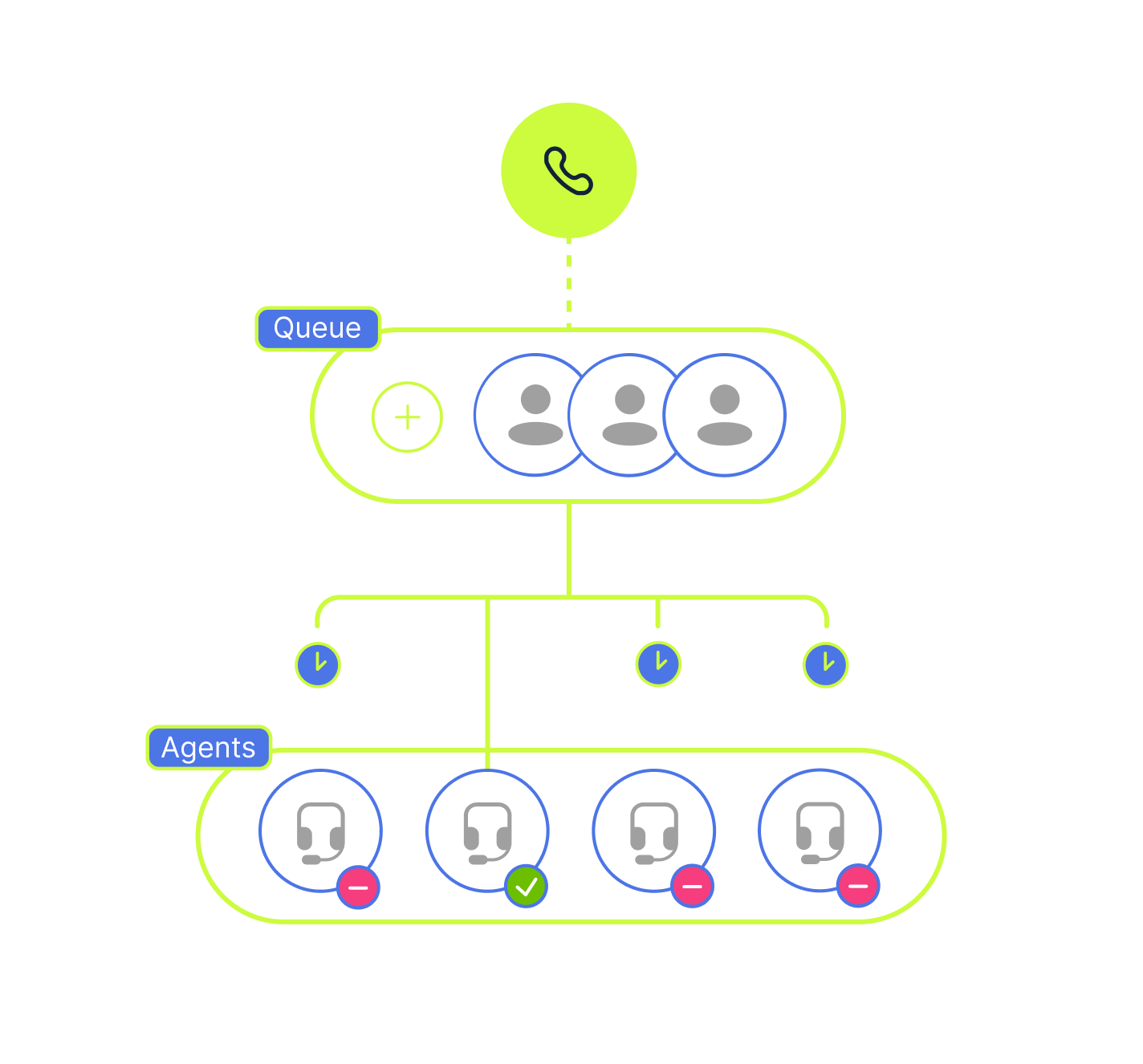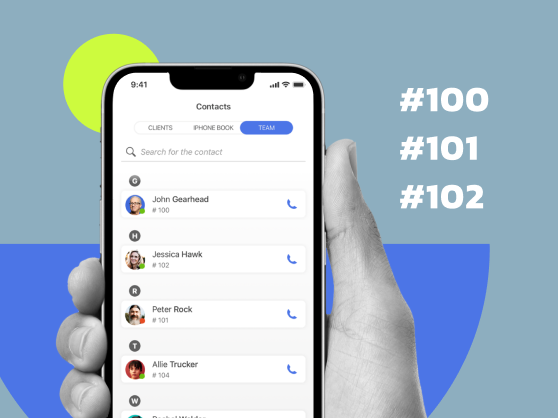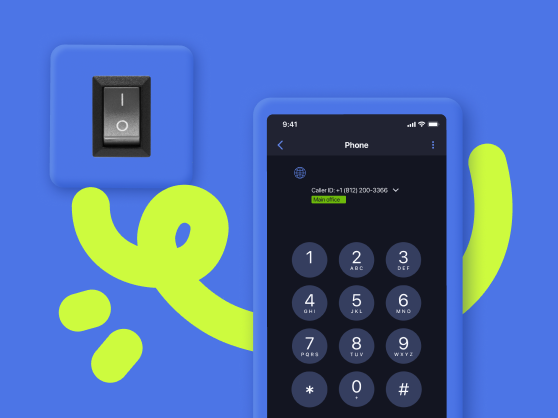What is a call queue?
A call queue is a feature that lets multiple callers “wait” on the line to speak with you instead of being disconnected automatically. With MightyCall, any number of callers can stay in the queue as they call in. While waiting, they can listen to a pre-recorded message about current sales, business hours, hold music, or choose to leave a voicemail. Paired with other features such as call transfer or Caller ID, this tool becomes extremely useful.
What does the call queue feature look like?
The feature is, in reality, a call routing system that you can set up for inbound calls. To find it, head to the Call Flow section of the MightyCall console. To access it, click the little gear symbol located inside the orange square at the bottom of the call flow.
A circle of options will then appear: the feature is on the top-left, in a purple circle. If you hover the cursor over, you’ll see a “Call Queue” label. This opens up a “Settings” window where you can customize everything and appoint agents who will respond to calls.
How to set up a call queue in MightyCall
- Start by going to the Call Flow section of the MightyCall console. After you’ve set up a flow, click on the circle of dots found on the bottom square. After you’ve clicked the dots, a variety of options will appear.
- To turn the feature on, click the purple call queue button in the top-left.
- In settings, you can establish how you’d like your customers to wait. You can also change call queue timing.
- Finally, at the bottom, you have the option to offer your callers to end their call by leaving a voicemail.
schedule your personalized demo with our amazing team

How does a call queue work?
This feature works intuitively:
- Callers are placed into a line and will be dealt with after your active call has ended.
- If in the Call Flow section you have selected multiple people in your team, you can decide whether all numbers are rang sequentially or simultaneously.
- Folks who are in line will hear an opening greeting message and then either music or some other uploaded .mp3, depending on which you have selected.
- If you’ve selected the option for them to hear a voicemail every certain amount of time, they’ll hear that as well.
What companies can benefit from this feature?
Call queuing is sometimes mistakenly considered a feature for call centers, with smaller companies thinking it’s too complicated for teams and unnecessary for customers. Our solution at MightyCall has been to address the issues at both ends, add ease of use, and simplify the reliability of call center queue technology for everyone involved.
Here are the companies that will definitely benefit from call queue management. Can you spot yours?
- Solopreneurs and very small teams: When you’re a one-man orchestra (or almost), time is of essential importance, and you can’t waste it on callbacks all day. A phone queue will automatically answer general questions on inbound calls, such as hours and location, while directing only important customer concerns to you at specific hours that you designate.
- Growing and mid-sized businesses: These companies need all the resources they can get, at an optimal price. Moreover, as your business expands, you get more people interested and calling, which means you need to boost the ROI of your communications.
- E-commerce stores: With several departments like billing, sales, and support, e-commerce stores have lots of calls coming in. During peak seasons, those calls can quadruple. A “call flow” tree will address general concerns, connect your various departments, and minimize waiting time for a practically unlimited number of callers.
- Companies with offices in two or more locations: Connect your offices to a single phone system and handle calls as easily as you would if your colleagues were sitting right next to you. Customers will never feel the difference.
- Remote teams: With modern VoIP technology, even a call center can work remotely. When you queue calls, you can connect as many agents as you want to. There’s no limit to the number of users, and since the platform is cloud-based, they can work from any location.
How to improve call queueing management?
- Set up business hours and non-working hours: Preliminary settings allow you to customize the way you handle and route calls depending on the working hours of your company and employees.
- Choose who will answer calls: You can customize the system by catering to callers in the queue according to the department or specific agent that will best address their concern.
- Set music on hold: Keep clients interested with fun or custom music and sounds while they’re on hold.
- Play pre-recorded messages while everyone is busy: Again, you can create custom audios or upload specific phrases you’d like your potential clients to hear. If you have a special sale or new store hours, now might be the time to inform them with a recorded audio message.
– What to play as a greeting: You can select either standard dial tone or music to make calling more pleasant.
– What hold music to play: Customize your on-hold music by uploading your chosen tunes.
– What to play if there are no agents available: If your clients are still waiting, pick different music or upload another sound file. - Possible options at the end of a call: Gently nudge clients to call a different number, play audio, or just disconnect.
- Invitation to leave a voicemail: Offer customers the option of leaving a voice message if they prefer not to wait for an agent to answer their phone call. This invitation will be repeated after a specified period of time.
How to configure and customize the call queue management feature in MightyCall
To get started with setting up call queuing, click the “Queue” button in the Flow tab. From there, select the flow you’d like to edit, and then click the dots on the square at the bottom of said flow. A pop-up window will appear with all of the possible settings you could need.
Initial setup
Before going for more advanced settings, check out the little “Sun” and “Crescent” icons in Call Flows. These are here to help you set specific waiting rules for working hours (the “Sun” icon) and non-working hours (the “Crescent” icon). Though you can choose simple “At all hours” routing for everyone, we suggest personalizing your waiting rules based on business hours.
Choose who will answer calls from the call queue
On the left of the pop-up box, you will see a list of all of the users in your system, each with a box next to it. You can switch between which receivers will respond to the phone call queue by checking the various boxes next to their names. You can do this at any time.
Add greetings
You can manage call queues with the following settings: what to play initially (music or just ringing), what hold music or tone to use, and what to play if no agents are available. For all dropdowns related to audio, you can choose from the default options provided or upload an external .mp3 file with a custom greeting you’ve created. To upload, simply click the green “Add Greeting+” button.
Possible options at the end of the call
If no one is available, you can finish with a dropdown at the bottom that provides five options: “Disconnect,” “Call to User,” “Play Audio,” “Leave Voicemail,” and “Call Any Phone Number” (non-MightyCall number). For options that require audio, such as “Play Audio,” an audio selection dropdown will appear. For options that require a number, like “Call to User,” a number dropdown will appear as well.
Invitation to leave a voicemail
When you have other calls waiting, you can offer callers in the queue to leave a voicemail. To do this, keep the box selected (it is selected by default), enter the number of seconds that should pass before the voicemail option is offered, and choose which number receives the voicemail (or click Invite+ to add others). Finally, click OK. Once voicemails are left, transcriptions will automatically be sent to your email so you can access them from anywhere.
To turn off this feature, simply undo the changes you made above.
Phone queues on Android and iOS
To have every MightyCall feature in your pocket, wherever in the world business finds you, download our free Mobile App for iOS or Android today.


What causes long call queues?
Whenever a caller has to wait on hold for over two minutes, the chance that they’ll have the persistence to wait or give you a callback is exceedingly slim. Long calling queues aren’t just inconvenient for callers; they are also a sign of poor organization within a company.
Reasons for long customer calling queues include:
- Few available agents: If your company has just a few agents handling inbound calls across several departments, your lines will ring like crazy, and customers will end up waiting for what may seem like forever. Whenever possible, designate different people to attend to calls in different departments.
- Seasonal call loads: If you’ve called a large company during the holidays, you probably know how frustrating it feels until someone picks up. Businesses like e-commerce get a huge influx of seasonal customers during peak times, so it’s advisable to worry about improving your call flows or hiring extra agents during peak seasons.
- Poor staff organization: Your call loads may not be that full, but due to poor organization, nothing just works the way it should. For example, you may have a great phone system, but your agents are not aware of how to set up call flows, or they haven’t been updated in ages. If that feels like you, check out how you can restructure queuing up calls to cut waiting time.
- Lack of modern technology: With some business communications systems, call handling can become a pricey option, so businesses would rather have long wait times and manually handle them than pay extra for a feature they think isn’t necessary. Voice over IP (VoIP) is a great option here as it provides exceptional call handling at no extra cost to the main subscription.
Why you should improve call queue management
Do you know that feeling when you call a business and are pleasantly surprised at how lightning fast your concern is addressed and solved? All of that without long wait lines, callbacks, and transfers to/from grumpy agents. Here are more of the smooth sailing vibes that efficient call queue management can provide:
- Happier clients: No more waiting for minutes in line, dropping the phone, and calling a competitor that just happens to answer right away. Let the happiness of your customers guide you in all organizational improvements.
- More productive employees: No more juggling communications errands, manually transferring calls, or worse – asking the customer to call another number! Take 5 minutes for setup, and your agents will save hours of productive time.
- Better teamwork: Hello, organized workday, where everything runs automatically and smoothly! Collaboration between departments and even offices in different locations can be completely automatic.
- Positive budgeting: With VoIP, you can create virtual queues as simple or as complex as your company needs. We can help you make call routing for a complex call center or a simple home business. All for a single, transparent cost of a business number with no pricey call queue software – our system is cloud-based.
Why use call queuing?
There are numerous reasons why this is such a key feature for so many businesses. Here are just a few:
- Don’t end your current call prematurely: If the person you’re talking to is very important – maybe they’re in the process of ordering a large sale – you likely won’t want to finish up with them in the middle because another important call has come in. With this feature, you don’t have to; they’re provided with a good “place”, which can be filled with information about your business (or can simply be forwarded to another employee).
- Provide answers without speaking: Many incoming calls will likely be mundane: when are you open until/do you have any sales-type questions? These can easily be answered by uploading audio, which can contain these answers. During their wait time, people can hear all about your special deals or new store hours. This filters out the ones who need less help.
- Give your team a breather: During busy days, business calls can come in nonstop. Perhaps you run a call center, and your team is accustomed to a higher call volume. Or maybe you run a tractor supply shop, and a new model just came in, and your team is not used to dealing with tons of incoming calls. This feature gives them the space to reach every client with peace of mind.
- Keep things orderly: Even if you do run a contact center, you still need organization. You can’t have your employees having to quickly pick up and do the “Please hold”, and then slam the phone down. A phone queue system enables businesses to handle heavy call loads in a calm and orderly manner.
Use case
Let’s imagine that you run a book shop. Normally, you’re not overly busy – it’s a book shop, after all, so maybe you get the occasional “Until when are you open” or “Do you have X” questions. However, during certain periods, things scale up considerably. For example, in August, kids need reading school materials, and when a major or popular book series comes out, everyone suddenly wants one. In these times, your lines are clogged; you don’t just have a second call, but you have a third, fourth, and fifth.
With our handy feature, all of those callers can have their questions answered without you having to speak a word to them. You can upload audio answering questions about whether you have the new book in stock, and therefore will only have to answer specific questions.
Helpful terms to know about call queuing
- Call Flow: This is the path or “flow” that a call will take when it comes in. You can set up every detail of this flow in the MightyCall console.
- VoIP: Standing for Voice-over-Internet-Protocol, is a business phone system that makes calls over the internet instead of traditional analogue lines. Making the switch to a VoIP phone system can provide you with lots of new and exciting possibilities, including a virtual phone call queue that’s as real and reliable as it gets.
- Call forwarding: This is a crucial feature that allows you to “forward” (that is, send) phone calls to other numbers. This way, someone can call a business number that you’ve advertised and then have it redirected to one of your employees who may be operating on a different number.
- VIP/Block List: This is a particular feature of the flow, but is important to recognize as a powerful tool. Phone queue options allow you to set up special paths for significant calls. With VIP, important calls can be directed to you even after office hours. Likewise, with Block, certain annoying callers can be hung up on without you having to do anything.
Ready to start using the call queuing system?
So, what is a call queuing feature? It’s a way to reach everyone who needs help without missing a single caller. When you have multiple incoming calls all at once, it’s important to respond promptly, or, if that’s not possible, to make sure the caller is addressed without them having to wait endlessly on the line.
This feature ensures that the concerns of all callers are acknowledged, making it a key part of customer communications. MightyCall provides this option in a format that is both accessible and easy to set up, even for those who aren’t especially tech-savvy. Our call queue software is straightforward and genuinely enjoyable to use.

























